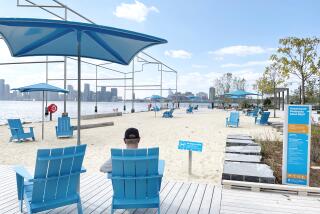At Coney Island, the Freaky Side Still Shows
- Share via
NEW YORK — Insectavora was running late, but the rest of the freaks, wonders and human curiosities took their seats on the bleachers at the Coney Island Circus Sideshow. Dick Zigun, known by many as “the mayor of Coney Island,” stood in front of the Chinese execution box and assumed a tone of grave sincerity.
Every year, as July 4 approaches, he gives the same preparatory speech to his cast: Do not mistake Coney Island for a totally domesticated place. When a million people crowd into a five-block stretch of Brooklyn, hellbent on having fun, you should brace for the occasional knife fight, thunderstorm or unexpected detonation of explosives.
“It’s not the bad people that are the problem. It’s the hundreds of people running away from the bad people,” Zigun, who founded Sideshows by the Seashore in 1985, said in his Sunday briefing. When crowds begin to run, the first thing Coney Island vendors do is pull down the gates in front of their businesses. “People try to crawl under the gate,” he said. “That’s why we have baseball bats.”
He didn’t have to explain this to Serpentina, who once had to vault into the theater holding a baby python over her head, like a cocktail waitress balancing a tray, after a fight broke out near the Polar Express ride. And the Twisted Shockmeister recalled the summer day he was onstage, eating glass, when a funnel cloud hopscotched over the amusement park. It sounded, he said, like thousands of horses running. An hour later, he emerged from the theater into dazzling sun.
That’s the nature of Coney Island, said the Shockmeister, whose name is Scott Baker. “It’s sort of Jekyll and Hyde.”
At the moment, Coney Island is on an upswing. Developed in the late 19th century as an airy seaside resort, the area began sprouting amusement parks in 1895: first the short-lived Sea Lion Park, then Steeplechase (where visitors raced on mechanical racehorses), Luna Park (the “Electric Eden”) and Dreamland (featuring a Lilliputian city populated by 300 midgets). With crowds dwindling, the last of these -- Steeplechase -- was torn down in 1966, signaling an end to the resort’s most prosperous years, according to Charles Denson’s history of the neighborhood, “Coney Island: Lost and Found.”
The “working man’s paradise” hit a low point in the 1970s, when prostitutes patrolled Surf Avenue and a street gang called the Homicides set up shop in the Bowery, Denson writes. City officials saw the park as tawdry, an embarrassment.
In 1975, William Conway, then general director of the New York Zoological Society, campaigned for the demolition of the Cyclone -- Coney Island’s iconic wooden roller coaster -- saying “the noise and the shrieking and the visual pollution” disturbed visitors to the New York Aquarium. The debate, Conway said, was “a clear choice between honky-tonk and culture.”
But the revival is unmistakable. Attendance last year topped 12.8 million, according to the Department of Parks and Recreation, up from 9 million in 2003. A mall developer has purchased 10 acres along the boardwalk for a hotel and entertainment complex; crowds pack into a new stadium for the minor league Brooklyn Cyclones.
This week, Brooklyn Borough President Marty Markowitz will flip the switch to ceremonially light the Parachute Jump, a 250-foot attraction that was left to rust in the salt air for 40 years. The ride was dismantled, repaired and painted its original colors. These days, Markowitz likes to refer to it as “Brooklyn’s Eiffel Tower.”
Still, the raucousness is in evidence.
“LOOKA LOOKA LOOKA” entreats a hand-painted sign on the corner of Surf and West 12th Street. On the boardwalk, crowds line up at a concession called “Shoot the Freak,” where they can aim paintball bullets at a human dancing around in a vacant lot. The soft-serve is pale green, for pistachio; the candy apples are impossibly, electrically red. Helen Melon -- “500 lbs. of female flesh” -- is advertised, and so is the Coney Island Gospel Tent’s five-day stop-smoking plan and the Spookarama.
Daniel Blake, who works for the sideshow, has studied the flow of people in Coney Island for years. His job, as a “spotter,” is to see trouble early enough to give the theater a 45-second warning. Problems can take the form of bad weather, crime, fireworks, drunkenness, or any combination of the four.
“Coney Island,” said Blake, who grew up here, “is almost like a Slinky caught between two universes”: one bright and cheerful, one dark and seamy.
Standing on the corner of Surf and West 12th, Blake said, he watches the balance shift on a nightly basis.
Sometime around 6 o’clock, he said, “you see the beautiful bright beach chairs leaving, the beach umbrellas, and behind them, just like an escalator or a revolving door,” the night visitors flow in.
At that moment, the air shifts, said Blake, who was wearing a black fedora and pointed white lizard-skin loafers. The night comes alive. As for the “9-to-5ers,” as Blake calls them, they must tear themselves away from the sea air and return to the steaming city. That realization, he said, brings aggression to the surface.
“It’s like Atlantic City. You got to go home and face reality again,” he said. “You’re leaving Coney Island.”
More to Read
Sign up for The Wild
We’ll help you find the best places to hike, bike and run, as well as the perfect silent spots for meditation and yoga.
You may occasionally receive promotional content from the Los Angeles Times.






